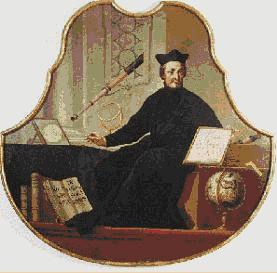Astronomy Bio...Christoph Scheiner
Jay Bitterman
Christoph Scheiner was born in Wald (near Mindelheim), Germany on July 25, 1573. He went to the Jesuit Latin School at Augsburg and the Jesuit College at Landsberg. He entered the Roman Catholic Jesuit order in 1595. In 1600 he studied philosophy and mathematics in Ingolstadt. From 1603 to 1605 he taught humanities in Dillingen and invented the pantograph - an instrument that was used to duplicate plans and drawings to any scale. In 1610 he returned to Ingolstadt to study theology. After completing his studies he was appointed as Professor of Mathematics and Hebrew at Ingolstadt University. It was there that he started to make astronomical observations in support of his own research and organized public debates on current issues in astronomy.

In 1611 Scheiner built his first telescope and commenced to make astronomical observations of the Sun. In 1616 he was invited to take up residence at the court in Innsbruck. In 1617 he was ordained to the priesthood. He was one of the first observers of the Sun to use a properly mounted telescope and was also aware enough to project the Sun's image onto a white screen in order to avoid damaging his eyes. Within a few weeks of observing the Sun he detected spots but his religious superiors did not want him to publish his observations using his own name in case he was mistaken and might bring discredit on the Society of Jesus (the Jesuit order). He communicated his findings to his friend, Marc Wesler, in Augsburg. Wesler sent printed copies to Galileo and Kepler using Scheiner's pseudonym. Scheiner conjectured that the spots were small planets that were circling the Sun. In a second series of letters, also published in the same year using the same false name, Scheiner wrote about the individual motion of the spots, their period of revolution and the appearance of brighter patches, or "faculae", on the surface of the Sun. He also concluded that Venus and Mercury revolve around the Sun after having observed their lower conjunction. His conclusion conformed to his religious belief that supported the traditional view that the Earth was at the center of the universe.
In spite of the fact that Scheiner had tried to conceal his identity, Galileo identified him and claimed priority for the discovery of sunspots, hinting that Scheiner was guilty of plagiarism. It appears that this criticism was unjustified because the sunspots were also observed independently, not only by Galileo in Florence and Scheiner in Ingolstadt, but also by Thomas Harriot in Oxford and Johann Fabricius in Wittenberg. In 1615 Scheiner published his "Solellipticus" and in 1617 "Refractiones Caelestes" which were both dedicated to Maximillian, the Archduke of Tirol. He drew attention to his observations of the elliptical path of the Sun near the horizon, which he explained as being due to the effects of refraction. Between 1626 and 1630, In his major work, "Rosa Ursina Site Sol", Scheiner described the inclination of the axis of rotation of the sunspots to the plane of the ecliptic, which he accurately determined to be 7°30', the modern value being 7° 15'.
As part of his work in astronomy, he also made significant improvements to the helioscope and the telescope.
Unfortunately, because he lived in an age when observational astronomy presented grave confrontations and contradictions to his theological principles, it affected Scheiner's scientific career and hindered the contributions that he might otherwise have made to the progress of science as a whole.
He died in Neisse (now Nysa in Poland) on June 18, 1650.





